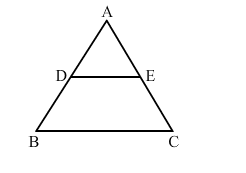In an equilateral ∆ABC, D is the midpoint of AB and E is the midpoint of AC. Then, ar(∆ABC) : ar(∆ADE) = ?

(a) 2 : 1
(b) 4 : 1
(c) 1 : 2
(d) 1 : 4
(b) 4:1
In ∆ABC, D is the midpoint of AB and E is the midpoint of AC.
Therefore, by midpoint theorem, DE
Also, by Basic Proportionality Theorem,
$\frac{A D}{D B}=\frac{A E}{E C}$
Also,
$A B=A C=B C(\because \Delta A B C$ is an equilateral triangle)
So, $\frac{A D}{D B}=\frac{A E}{E C}=1$
In $\triangle A B C$ and $\triangle A D E$, we have :
$\angle A=\angle A$
$\frac{A D}{A B}=\frac{A E}{A C}=\frac{1}{2}$
$\therefore \triangle A B C \sim \triangle A D E(S A S$ criterion)
$\therefore \operatorname{ar}(\triangle A B C): \operatorname{ar}(\triangle A D E)=(A B)^{2}:(A D)^{2}$
$\Rightarrow \operatorname{ar}(\triangle A B C): \operatorname{ar}(\triangle A D E)=2^{2}: 1^{2}$
$\Rightarrow a r(\triangle A B C): a r(\triangle A D E)=4: 1$
Click here to get exam-ready with eSaral
For making your preparation journey smoother of JEE, NEET and Class 8 to 10, grab our app now.
